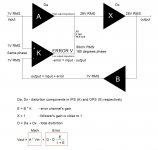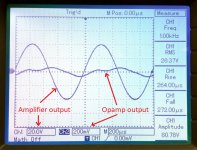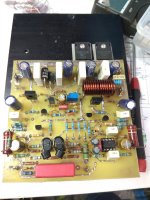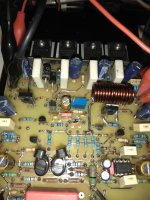You say that, but without any proof?
Why a proof is needed at all? I think it is still under normal working electronics. To start with, CFP drivers do not need high current drive.
No smoke, playing but 1.5v dc at the output.
Pulling or placed offset i.c not much difference. 😕
Power supply +/-50v.
Pulling or placed offset i.c not much difference. 😕
Power supply +/-50v.
No smoke, playing but 1.5v dc at the output.
Pulling or placed offset i.c not much difference. 😕
Power supply +/-50v.
How about matching, have you done any matching?
How about matching, have you done any matching?
Not at all!
I leave all the hard work to the servo!
Last edited:
All input transistors changed, using still unmatched but Fairchild this time.
Offset is now 700mV, servo pulled.
I think not bad..
Offset is now 700mV, servo pulled.
I think not bad..
Thank you Valery. Some years ago I simulated ODNF and have found that is quite sensitive (read not easy) to set it correctly, never tried real amplifier.
What is your experience with ODNF in real amp?
Best wishes,
Damir
Yes, I used it in my Simpelstark amplifier with very good results.
See the schematic of one of my successful ODNF implementations attached.
I left the reference numbers as is, left from my complete schematic - never mind.
Please note:
- it is important to have C18 in place for phase correction at HF. Its value strongly depends on the Opamps type, used in the circuit. OPA2134 and 27pF are showing excellent results.
- In order to set the error detector correctly, you need to run 1KHz sine wave through the amp, connect the oscilloscope to TP2 point and rotate R26 trimmer until you see the lowest amplitude of the error signal at TP2.
Before you apply ODNF, you need to set the overall open loop gain of your amplifier to the value you like (I normally set it to 29db or so).
You can do it in two places:
1) slightly degenerating the IPS;
2) loading the VAS (R21 in my case).
Here are a few links so that you can see the full schematic (earlier version - does not matter), as well as my finished amplifier:
https://www.diyaudio.com/forums/solid-state/312866-global-loop-amplification-18.html#post5347597
https://www.diyaudio.com/forums/solid-state/96192-post-solid-pics-592.html#post5579612
I like ODNF a lot - designed some other implementations of the principle using jFETs and even the vacuum tubes in the error channel - cool stuff.
Let me know if some clarifications are required.
Cheers,
Valery
Attachments
All input transistors changed, using still unmatched but Fairchild this time.
Offset is now 700mV, servo pulled.
I think not bad..
700mV is still quite a loot for servo.
What about +-15V, what zener resistor are you using?
Yes, I used it in my Simpelstark amplifier with very good results.
See the schematic of one of my successful ODNF implementations attached.
I left the reference numbers as is, left from my complete schematic - never mind.
Please note:
- it is important to have C18 in place for phase correction at HF. Its value strongly depends on the Opamps type, used in the circuit. OPA2134 and 27pF are showing excellent results.
- In order to set the error detector correctly, you need to run 1KHz sine wave through the amp, connect the oscilloscope to TP2 point and rotate R26 trimmer until you see the lowest amplitude of the error signal at TP2.
Before you apply ODNF, you need to set the overall open loop gain of your amplifier to the value you like (I normally set it to 29db or so).
You can do it in two places:
1) slightly degenerating the IPS;
2) loading the VAS (R21 in my case).
Here are a few links so that you can see the full schematic (earlier version - does not matter), as well as my finished amplifier:
https://www.diyaudio.com/forums/solid-state/312866-global-loop-amplification-18.html#post5347597
https://www.diyaudio.com/forums/solid-state/96192-post-solid-pics-592.html#post5579612
I like ODNF a lot - designed some other implementations of the principle using jFETs and even the vacuum tubes in the error channel - cool stuff.
Let me know if some clarifications are required.
Cheers,
Valery
Thank you Valery, I have to go back to my simulation to see what result I had.
I see that you in business now, the amp looks really nice.
What about output impedance, I forgot what ODNF is doing with it?
BR Damir
I used 3k9//10k.700mV is still quite a loot for servo.
What about +-15V, what zener resistor are you using?
I measured - 14.9v and +15v.
Attachments
Last edited:
Thank you Valery, I have to go back to my simulation to see what result I had.
I see that you in business now, the amp looks really nice.
What about output impedance, I forgot what ODNF is doing with it?
BR Damir
You can consider ODNF as global feedback, implemented in a special way.
It does not change the gain of your original amplifier (it adds 18db to original gain and then suppresses it back to the initial value), however, it decreases the output impedance, noise, and distortion, as the normal feedback would do, but preserving the "character" (harmonics profile, phase coherence) of the original amplifier.
It works especially well with the amplifiers having good open loop characteristics - high enough speed (bandwidth) and linearity - cleaning up the higher order components, resulting in highly natural, "live" sounding.
I used 3k9//10k.
I measured - 14.9v and +15v.
It's 2k8 a bit tu much, and you have difference in voltage. What is DC output with DC servo in?
Damir, I've just realized one thing...
You're in Zagreb. I'm in Ljubljana right now - I come here more and more often, arranging some business and place for living. I need to fly to Moscow today, but next time...
You're just in 1:35 drive from me 😉
Shall we have a glass of wine the other day? I will come to Zagreb no problem.
I'll let you know when I'm next time in Ljubljana 😀
You're in Zagreb. I'm in Ljubljana right now - I come here more and more often, arranging some business and place for living. I need to fly to Moscow today, but next time...
You're just in 1:35 drive from me 😉
Shall we have a glass of wine the other day? I will come to Zagreb no problem.
I'll let you know when I'm next time in Ljubljana 😀
Damir, I've just realized one thing...
You're in Zagreb. I'm in Ljubljana right now - I come here more and more often, arranging some business and place for living. I need to fly to Moscow today, but next time...
You're just in 1:35 drive from me 😉
Shall we have a glass of wine the other day? I will come to Zagreb no problem.
I'll let you know when I'm next time in Ljubljana 😀
Valery that is excellent idea, let me know and we will a glass of wine and good music.
😀
I'm using 3K9//10K.
Zener voltage is - 14.9v and 15v.
You answered twice the same, look my question before that post.
It's 2k8 a bit tu much, and you have difference in voltage. What is DC output with DC servo in?
With servo in, offset is 7mV
Last edited:
Now all transistors are tight each other and offset using servo is 0mV.
Nice to hear that, any sound coming out?
Yes it play nicely up to now..... but now i see periodically instability.Nice to hear that, any sound coming out?
You can hear this through speaker and measured strange dc on output. It is like microphone feedback.
I think that is worst after the second pair of latfets installed or nothing to do?
Now come in my mind that testing with ARTA today morning sometimes signal jump
Attachments
Last edited:
Yes it play nicely up to now..... but now i see periodically instability.
You can hear this through speaker and measured strange dc on output. It is like microphone feedback.
I think that is worst after the second pair of latfets installed or nothing to do?
It could be that DC servo is straggling with to much of DC offset?
- Home
- Amplifiers
- Solid State
- Lateral CFA 120W - BSA



